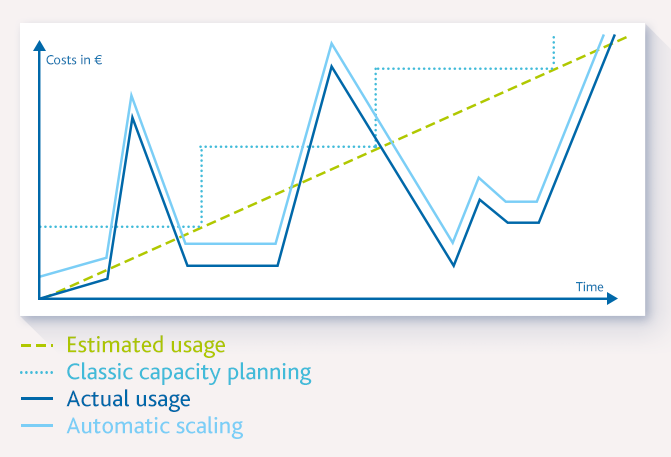
How Does It Operation from the Cloud Benefit You?
Investment, Operating, Transaction, and Opportunity Costs Briefly Explained
Cloud Computing as an IT Service Model
Cloud computing is an IT service model in which hardware and software are provided to customers over the Internet on-demand - autonomously and independently of device and location. The required IT resources are dynamically scalable, quickly available, and ready for use with minimal interaction with the service provider or cloud provider.
The Core of Cloud (Costs) I: Investment vs. Operating Costs

Services from the cloud are used as a service. Therefore, cloud services incur little to no investment costs but can be billed as operating costs. The company does not have to invest in hardware to provide suitable IT infrastructure. Studies show that most IT resources use only 10 to 30% of their available computing power in the process. A large part of the resources thus remains unused, even though they are permanently available.
The figure uses an example to illustrate that there is a large difference between actual utilization and available resources in classic capacity planning: Whenever actual utilization is above classic capacity planning, IT resources are insufficient. If actual utilization is below planned capacity, IT resources remain unused.
No investing without transaction costs
In classical capacity planning, new investments are required each time capacity is increased. This means that the committed capital increases with each capacity increase. At the same time, transaction costs are also incurred with each investment. These are - depending on the amount of the investment - not insignificant.
IT resource planning with a safety net
Looking at the level of investment required in new IT resources, it is noticeable that capacities are planned for a longer period and forecast for times of maximum demand. This means that investments are often higher. They serve both a longer period and potential growth or higher demand than they would have to at the time of the investment.
The Core of Cloud (Costs) II: Only Pay What You Use
Cloud computing can help companies to shorten long procurement processes or investment approval processes. This is because the costs for cloud services are directly related to the actual use of resources: Here, only the actual load is paid for. This is also referred to as a change from CAPEX (investment costs) to OPEX (operating costs).
The green line (automatic scaling) in the diagram shows how the service model and usage-based payment work in cloud computing: IT resources scale analogously to actual demand.
If demand increases, more capacity is made available for IT applications. When demand peaks, costs naturally rise as well. There is certainly a good reason for this: if the application is used more, more revenue can be generated via an online store, for example.
If demand drops, IT resources scale down. This has the opposite effect. Cloud computing can thus increase profitability by improving resource utilization. Costs are reduced by providing suitable resources only for the time they are needed.
Those who plan classically also pay for what they do not use at all
In addition to the investment costs, classical capacity planning also involves possible opportunity costs - i.e., the costs that arise when systems remain unused and tie up capital.
The graph shows that the actual utilization in the classic model is regularly below the possible capacity. We understand the difference between the actual utilization and the possible capacity as opportunity costs.
Actually, the company would have to hold less capacity in case of lower demand. The resources tied up in maintaining this capacity could then possibly be put to better use elsewhere. The company has thus foregone using the resources for the excess capacity to carry out other entrepreneurial activities.
Using cloud services to save costs and set focus
Further opportunity costs are incurred, particularly by smaller companies, which generally do not have their own IT specialists. Here, the management of IT solutions is often the responsibility of a staff unit that has a certain IT affinity but lacks IT background knowledge in dealing with complex technologies. The focus of such staff units is often on other key topics such as finance and accounting. Therefore, the person in charge is unable to focus on their core competencies during this time, which results in high opportunity costs.
Cloud services - when used correctly - not only help companies to save costs. Their use also ensures more focus and strengthening of the core business, since cloud computing as an IT service model from IaaS, PaaS to SaaS can reduce the in-house support effort for infrastructure and applications.
Written by

Doro Brockschmidt is a Customer Success Manager focusing on cloud technologies and digital sovereignty. She combines expertise with practical examples to support companies in transforming their IT landscapes.

